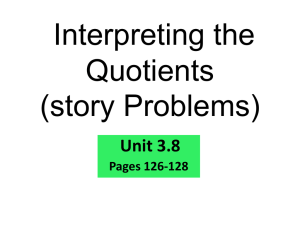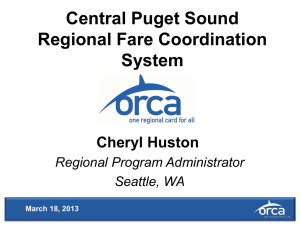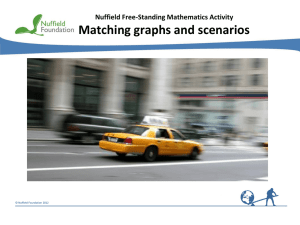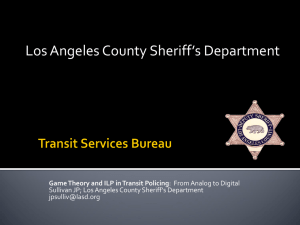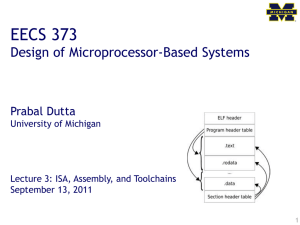Social Equity in Distance Based Fares
advertisement
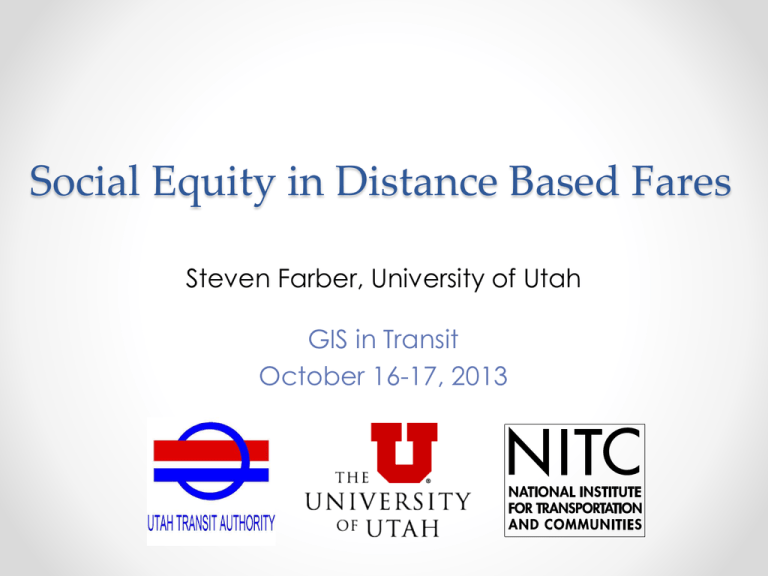
Social Equity in Distance Based Fares Steven Farber, University of Utah GIS in Transit October 16-17, 2013 Background • UTA transitioning from a flat fare to a distance based fare • Title VI and EJ requirements (differential impacts) • Different populations will be impacted differently since trip gen’s and distances travelled vary systematically with demographics • Understanding of travel behavior required to assess differential impacts Fares and Sustainability • Competing goals of transit agency o Economic – Increase Revenue o Environmental – Decrease automobile use o Social – Provide transit service to those in need or equally to all • Distance based fares o Economically efficient (capturing external costs) o Socially beneficial (shorter but more frequent trips) o Environmentally detrimental (increased costs for long distance discretionary riders) Fares and Equity Social equity in transportation is summarized by Sanchez as the distribution of “benefits and burdens from transportation projects equally across all income levels and communities” Fairness: Whether the costs and benefits are equal after taking needs, means, and abilities into consideration. Are we interested in equality or fairness? Equity Fairness / Transit Fare Taxation Flat fare per trip Fixed tax dollar amount regardless of income Distance based fare (DBF) Single tax rate for all DBF with reduced cost of successive starts Progressive tax rates (sliding scale) Research Questions • What are the social equity and fairness impacts of a transition to DBF? • How can travel behavior be used to assess social equity in this case? • If DBFs are generally desirable, how can we find and address exceptions to this rule? Data • Utah Household Travel Survey o o o o o Spring 2012 1 day travel diary 9,155 Households 27,046 People 101,404 Trips • Filtered to only those residing in UTA’s core service area - 68% of respondents • # daily of transit trips • Daily distance travelled by transit Observed Travel Behavior Ridership Percentage Household Income No Answer Under $35,000 $35,000 - $49,999 $50,000 - $99,999 $100,000 or more Hispanic Yes No Prefer not to answer Race White or Caucasian All other Age 18-24 years old 25-34 years old 35-44 years old 45-54 years old 55-64 years old >65 years old Distance Trips Travelled (miles) 1.91 5.17 2.94 2.24 2.17 1.73 1.94 1.88 1.85 1.86 20.09 13.25 19.14 20.56 24.51 4.38 2.60 3.02 1.89 1.88 1.64 17.39 19.60 5.34 2.50 4.61 1.89 1.77 19.93 14.25 6.87 4.07 3.37 3.49 3.13 1.59 1.82 1.88 1.84 1.87 1.88 2.08 17.47 17.51 24.19 19.73 17.82 13.91 Ridership Percentage Education High school or less Some College/Vocational/Associates Bachelors Grad/Post Grad Licensed Yes No Number of vehicles Zero vehicle household 1 vehicle household 2 vehicle household 3+ vehicle household Home Ownership Rent Own Other Residence Type Single-family house (detached house) Apartments Other Distance Trips Travelled (miles) 3.73 3.40 2.90 5.26 1.85 1.87 1.80 1.95 13.08 18.56 19.34 21.88 3.14 13.67 1.86 1.96 20.39 11.34 27.34 5.40 1.87 1.99 2.26 1.78 1.89 1.81 7.42 14.04 23.70 23.21 5.56 2.17 0.77 1.86 1.87 2.00 11.66 22.77 17.61 2.17 6.17 3.34 1.88 1.92 1.74 22.82 11.38 13.89 Selection of Fares • UTA is considering fares that consist of a flat component and a distance-based component • For this study, we selected a revenue-neutral fare o $0.50 + $0.19 per mile • Distance is measured as Euclidean distance so that users are not penalized by indirect network design Transit Trips Household Income Under $35,000 $35,000 - $49,999 $50,000 - $99,999 $100,000 or more Hispanic Yes No Race White or Caucasian All other Age 18-24 years old 25-34 years old 35-44 years old 45-54 years old 55-64 years old >65 years old Distance Travelled Flat Fare Distance Percentage Based Fare Change 1.94 1.88 1.85 1.86 13.25 19.14 20.56 24.51 4.85 4.70 4.63 4.65 3.49 4.58 4.83 5.59 -28.1% -2.6% 4.5% 20.1% 1.89 1.88 17.39 19.6 4.73 4.70 4.25 4.66 -10.1% -0.8% 1.89 1.77 19.93 14.25 4.73 4.43 4.73 3.59 0.1% -18.8% 1.82 1.88 1.84 1.87 1.88 2.08 17.47 17.51 24.19 19.73 17.82 13.91 4.55 4.70 4.60 4.68 4.70 5.20 4.23 4.27 5.52 4.68 4.33 3.68 -7.0% -9.2% 19.9% 0.2% -8.0% -29.2% Method • Estimate a joint model of transit trip generations and distance travelled • Spatially expanded coefficients – controls for contextual information not captured in the dataset • Convert travel behavior to fares and compare results Ordered Model Estimates Continuous Model Estimates B 0.9052 p-value 0.0000 -0.1468 0.0607 2 1.4356 2 Age less than 17 years Age 18-24 years Age over 65 * 𝑢 B -3.9564 p-value 0.0000 Two transit trips 1.1045 0.0000 0.0193 Three transit trips 1.5018 0.0000 Constant Age over 65 * 𝑣 Mobility Limitation * 𝑣 0.8022 0.0167 Age over 65 -0.2700 0.1709 -0.3858 0.0956 No children or retirees -0.1596 0.0821 Household w/ retirees -0.3449 0.0004 Student, em. < 25 hrs/week -0.2771 0.1868 0.9011 0.0000 Unemployed/retired -0.2670 0.0483 -0.4158 0.0000 High school or less * D_CBD -0.0072 0.0619 -1.1084 0.2099 Hispanic - Refusal -0.5133 0.0464 1.8918 0.0003 Race: non-white * D_CBD 0.0199 0.0052 -0.3251 0.0000 Race: non-white * 𝑣 -0.4355 0.1926 0.1842 0.0001 Zero vehicles * D_CBD -0.0132 0.0275 Self employed Student, emp. 25+ hrs/week Unemployed/retired * 𝑢 Unemployed/retired * 𝑢 2 Grad. or post-grad. degree Female 1.1440 0.0446 Income < $25K * 𝑢𝑣 -0.8834 0.0818 -1.2459 0.0902 Income $75-$100K -0.4831 0.0001 -2.4449 0.0011 4 people 0.1759 0.1779 -1.3931 0.0000 3+ workers 0.2371 0.0917 No driver’s license * 𝑣 1.4272 0.0016 3+ children’s bikes 0.2400 0.1706 Zero vehicle household -0.7612 0.0000 5+ years in current res. 0.1163 0.1723 2 vehicle household 0.3455 0.0000 City, residential neigh. -0.1825 0.0500 3+ vehicle household 0.5623 0.0000 Distance to CBD 0.0522 0.0000 Income < $25K * 𝑢𝑣 -0.5827 0.1106 Distance to bus stop 0.1421 0.1002 𝑣 Hispanic Hispanic * 𝑣 2 Hispanic * 𝑣 No driver’s license Income – Refusal Household rents * D_CBD Household rents * 𝑢𝑣 Household Tenure - Other 2 0.0087 0.0001 𝑣 -1.1271 0.0004 Joint Model Parameter Estimates 0.6485 0.1282 0.1788 0.0003 17.4178 0.0000 -15.0180 0.0000 p-value 0.0000 0.8261 0.0700 𝜇1 B -1.3672 -0.1580 0.0740 𝜇2 -1.5167 0.0000 0.2259 0.0186 𝜇3 -2.4753 0.0000 6+ people -0.2206 0.0076 𝜌 -0.1883 0.0625 Suburban mixed neighborhood -0.1226 0.0211 𝜎 0.8322 0.0000 0.0024 0.2466 0.4476 0.0410 Household Tenure - Refusal 3+ workers 3+ children’s bikes Distance to Commuter Rail 𝑢2 2 Log-Likelihood: -3701.04; p(𝜒 )<0.0000; McFadden’s Adj. 𝜌2 : 0.1144; pseudo-𝑟 2 =0.5782; 𝑛=16071 A B Low Income & Education Ref. 0 10 Miles C 0 10 Miles Low Income & Elderly 0 Distance Travelled (Miles) <2 5-6 9 - 10 22 - 26 40 - 45 2-3 6-7 10 - 14 26 - 30 45 - 55 3-4 7-8 14 - 18 30 - 35 > 55 4-5 8-9 18 - 22 35 - 40 Bus Routes D 10 Miles Non-White 0 10 Miles A B Low Income & Education Ref. 0 10 Miles C 0 10 Miles Low Income & Elderly 0 Ratio of Expected Distance Based Fare to Flat Fare < 0.35 0.65 - 0.75 1.05 - 1.25 2.50 - 3.00 0.35 - 0.45 0.75 - 0.85 1.25 - 1.50 3.00 - 4.00 0.45 - 0.55 0.85 - 0.95 1.50 - 2.00 > 4.00 0.55 - 0.65 0.95 - 1.05 2.00 - 2.50 Bus Routes D 10 Miles Non-White 0 10 Miles Census Tracts Most Non-White Most Hispanic Cost Ratio < 0.95 0.95 - 1.05 1.05 - 1.25 1.25 - 1.50 1.50 - 2.00 2.00 - 2.50 2.50 - 3.00 3.00 - 4.00 > 4.00 Conclusions • Distance based fares generally result in cheaper fares for those who need it most • Pockets of mismatch exist – suburbanization of the poor poses a problem • Burden on long-distance low-income travellers can be mitigated through reduced flat-fare components • Changes in price are likely to shift wealthy discretionary riders back to their cars, but it may attract a plethora of new low-income riders Next Steps • Developing a GIS Decision Support System • Analysts at UTA can compute fare surfaces for different demographic profiles and different fare structures • Targeted studies of riders in particular at-risk neighborhoods identified by the DSS Acknowledgements • • • • Xiao Li, Graduate RA Keith Bartholomew, UofU Antonio Páez, McMaster University Khandker M. Nurul Habib, University of Toronto • Utah Transit Authority • Partial support from: o National Institute for Transportation and Communities (DTRT12-G-UTC15540) o National Science Foundation (BCS-1339462)

